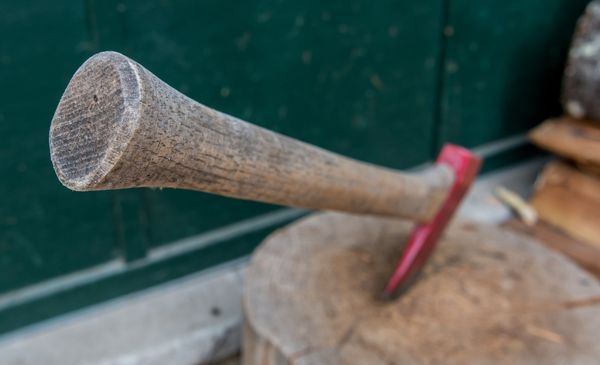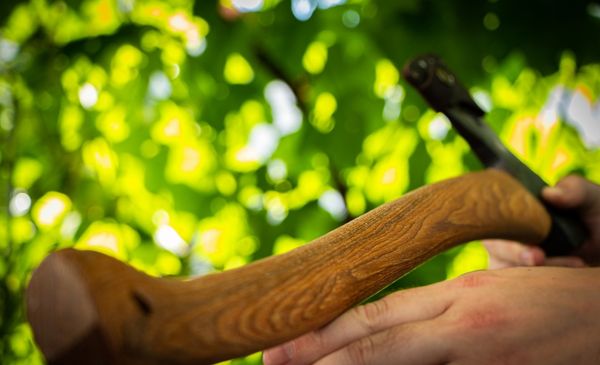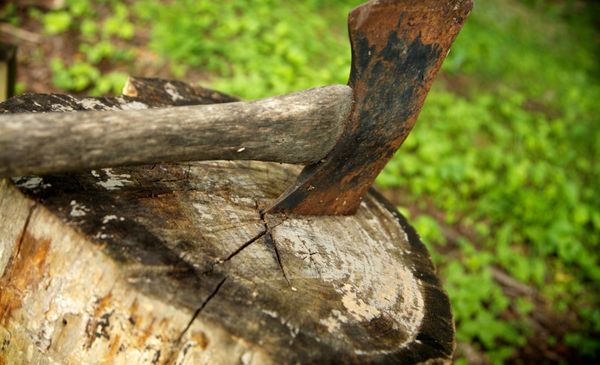Post Updated: 25 Feb 2023
There isn’t one universal handle that will fit every axe, but there ARE standard sizes of axe handles that are usually pretty similar from one manufacturer to another.
These standard sized handles are produced as replacement handles for the many different types of axe and striking tools available today.
TABLE OF CONTENTS:
Straight to the point – Best Wood For Axe Handles
Hickory is capable of absorbing a huge amount of impact without splitting or cracking, making it the perfect wood for an axe handle. Oak or Ash are other popular choices.
How to choose the right axe handle
The key to figuring out which axe handle is best suited to your axe is firstly to know the type of axe you have. A full size felling axe will generally have a 30″ to 36″ handle for a 3 to 5lb axe, while a double-bit cruiser axe handle is around 20″ long for a 2.5lb axe for example.
The other consideration is the eye of the axe. This is where the handle goes through the axe head to secure it firmly in place.
Depending on the type or brand of axe, the eye will be a specific size which should be matched to one of the standard sized handles for that specific axe.
Related Article: Is it better to oil or wax an axe handle?

The top of the new handle should be a slightly larger diameter than the eye – you would simply remove as much wood as necessary to ensure a snug fit.
It’s important to use the correct handle to ensure the weight and swing ergonomics are perfectly suited to the type of axe you are using, but as with any tool they can be modified slightly to suit the end user.
For example, you could opt for a thicker handle on your axe or you could shorten the handle of your chopping axe, it’s really up to you.
Standard axe handle sizes
Keeping in mind there may be slight differences between manufacturer, the following should give you a good idea of the various axe handle sizes that are suitable for your axe type.
I’ve added a few links to some hickory replacement handles that you can pick up for a decent price. Axe handles are generally quite cheap to replace.
- Hatchet – Handle Length: 12″ to 18″ – For 1.25 to 1.75lbs axes
- Felling Axe – Handle Length: 30″ to 36″ – For 3 to 5lbs axes
- Boy’s Axe – Handle Length: 24″ to 28″ – For 2.25 lbs axes
- Double Bit Cruiser Axe – Handle Length: 28″ – For 2.5 lbs axes
- Full Double Bit Axe – Handle Length: 30″ to 36″ – For 3 to 5lbs axes
- Miners Axe – Handle Length: 18″ to 27″ – For 3 to 5lbs axes
- Splitting Maul – Handle Length: 36″ – For 6 to 8lbs mauls

Axe handle material
The traditional material used for axe handles is wood, but there are several varieties of composite materials used nowadays that are undoubtedly more durable but perhaps not as ‘classic’.
Due to it’s combined strength and flexibility, American hickory is the most commonly used material for axe handles. Hickory is capable of absorbing a huge amount of impact without splitting or cracking, making it the perfect wood for an axe handle.
Related Article: Why do axes have curved handles?
A wooden handle is generally considered ‘best’ by by the majority of axe owners because it feels better – more organic – than plastic… and it looks epic! It’s also easier to replace a wooden handle than a fiberglass one.
The downside is that wood is more sensitive to the environment than a plastic handle so it needs a bit more care to keep it healthy.

Axe handle care
An axe is a simple tool, just a piece of steel attached to a piece of wood, but it’s one of the oldest ever tools designed by man and it’s still going strong – so give it some respect!
Hickory is widely accepted as the best material for an axe handle due to it’s natural strength and flexibility and of course, it’s aesthetics. It will take care of you if you take care of IT.
- Axe handles left exposed to the elements may shrink, warp or splinter regardless of how good the axe is or how much money you spent. Keep your axe in a dry, well ventilated area to avoid shrinkage. A climate controlled building is best
- If transporting, keep it within the vehicle or ideally in a box for transportation – keep it out of the elements for prolonged periods
- Regular treatment of boiled linseed oil will prevent moisture ingress and limit shrinkage
- Don’t stack heavy objects on top of your axe or leave it leaning against a wall – this can warp the handle
- Do not use the poll of your axe as a sledgehammer, this can distort the eye and cause the axe head to loosen or crack – it was designed to chop wood not hammer against steel!
Related Article: Best axe handle finish – Tung oil or boiled linseed oil?
Curved vs straight axe handle
The curved axe handle has been dominant for over 170 years where originally they were just a straight piece of wood. There are arguments on both sides whether the curved handle is superior to the straight handle, but curved has become the norm – probably due to looks alone.
The curved handle is shaped in such a way that when held, the cutting edge of the axe is ‘righted’ in your hands. The one place where you would still find a straight handle vs curved is the double bit axe.
These have two cutting edges opposite each other, so the curved handle doesn’t make sense in this situation – since there is no dominant edge to ‘right’ – if you know what I mean!
Conclusion
I hope this short article has been of some use to you. I am currently working on some axe handle replacements that I hope to document on this site soon – like a how-to guide from start to finish, so subscribe to my mailing list if you want regular updates on new posts.

Leave a Reply